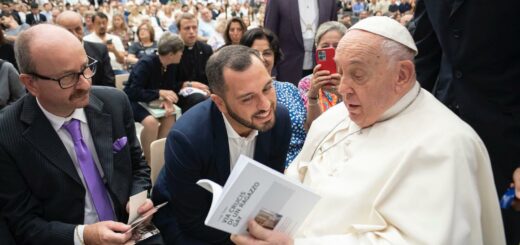Love, coexistence, the sacrament: a renewed biblical gaze on the couple
Biblical reflections of the Pastora Battista Lidia Maggi published on the site Solid June 15, 2011
What distinguishes the bond that unites a couple married by someone who chooses to live together? In addition to the legal relationship that protects instead of each other, I confess that, sometimes, struggling to grasp the substantial difference in the quality of the relationship, especially on the long times.
Is it the lack of the marriage contract that makes that bond less sacred? Is coexistence a form of second choice love? I met couples of spouses and cohabitants who live their love relationship in the deepest dedication. Difficult to distinguish. And if they are not able to fully understand the difference in the bond, how to explain it to the reader and, above all, to future generations, to my own children? I am not the right person to make an apology for marriage, despite being minister of a church. At one time I did not think so, I was convinced that, through that rite celebrated before God and the meeting gathered, a unique, unrepeatable bond was established that no other form of union could match. I felt the difference between married and cohabitants, not only linked to the legal aspect of the Union. Life and experience have made me more cautious in easy distinctions. I happen to marry young couples, to accompany them in the preparation for the celebration, as well as I listen to labors and joys of couples who are not legally married.
Love is love
It is precisely in listening to the most diverse stories that I begin to mature the belief that love is love, whether we like it or not, even if this is expressed in a method other than the conventional one. This also means that it can also be considered true love that unites two people of the same sex, homosexual love.
I realize that I reflect on this theme by reading reality with my Protestant lenses: in Lutheran and reformed churches the marriage is not a sacrament. This does not mean that the love that unites two people is not sacred. In fact, the relationship is sacred, because this is a metaphor for the bond that unites God with humanity.
The biblical God reveals himself as a you who call, who binds to a particular story. It is always the God of someone: the God of Abraham and Sara, Isaac and Rebecca, Jacob and Lia and Rachel, the God of Jesus: mine and your God. The relationship with God can be very intimate, but he can never become fusional, otherwise God is reduced to an idol.
God is the other who walks with humanity without (with) merge into it. We know this game of intimacy and otherness in particular in the emotional relationship.
The sacrament of love
In this sense, the love relationship is "sacrament": it refers to the greatest reality that is the relationship between God and humanity. And, consistently to the biblical testimony, it does so "to the plural". The "singular" of the marriage choice has so far been defended as a definitive choice, indissoluble link. But in the present, the paradigm of definitiveness no longer appears to be tied to marriage. I am not a sociologist; But from my limited pastoral observatory I see that the holding of the couple bond, as well as its breakdown, occurs both for the married and for cohabitants. Definitiveness no longer appears exclusive to marriage. It is also said that only the wedding would be able to express the public implication of the choice of a couple, not relegating it to a private matter. The problem is real and, in my opinion, must be framed in the broadest question that today we no longer have symbolic moments that tell the decisive passages of existence. The so -called initiation rites have failed in our company. But even in this case, it is not said that the marriage is able to perform this function. Or rather, that it is the only way to express the public moment of life as a couple.
Chissà se le chiese, in futuro, saranno in grado di proporre un gesto che conferisca senso “iniziatico” e valore pubblico alla relazione amorosa della coppia, non necessariamente col linguaggio giuridico del “io prendo te, io mi impegno per sempre”, ma anche con quello differente del “io inizio con te un cammino”.
Dai frutti vi riconosceranno
In fondo, anche per le coppie vale il doppio sguardo che i credenti accendono sull’esperienza della fede cristiana. Ovvero: osservandola dalle “radici” oppure dai “frutti”. Se finora la preoccupazione delle chiese si è concentrata sulle radici, sul porre un gesto pubblico, ufficiale, sacramentale quale la celebrazione del matrimonio, perché non provare a guardare anche ai frutti? Ci sono persone sposate che hanno trasformato la loro unione in una prigione eppure continuano a rimanere assieme; coppie che, invece, hanno trovato nel matrimonio il terreno fertile per far crescere la relazione d’amore. Lo stesso vale anche nelle convivenze. Ho incontrato persone che, pur non essendo legalmente sposate, non riescono a separarsi anche quando ormai la convivenza è usurata e l’antico terreno fertile dell’amore è diventato un campo di battaglia. Da questo punto di vista, lo sguardo si posa sia su convivenze riuscite che su quelle malate, sia sui matrimoni di interesse che su matrimoni che tengono e testimoniano una ricca relazione affettiva.
Ogni storia d’amore è originale
All this to affirm: the stories are singular and difficult to judge a priori. At the school of Scriptures we learn not the judgment on the principles, but the attentive and non -judgmental listening, capable of discerning every single story, avoiding generic simplifications. On this theme I greatly appreciated the interventions that appeared on these pages of those who preceded me. I ask myself the acuteness of Battista Borsato who offers us, in contrast, a possible positive reading of coexistence as a "sign of times". In this phenomenon he sees in this phenomenon the possibility that the Church wonders how he managed the ministeriality of the spouses, considering them immature people, to be ruled with clear instructions on how to manage sexuality, procreation, education of children. Those who choose to live, consciously or not, subtract from this control by claiming total autonomy on as intimate choices as the management of sexuality.
I then found the reflection of Luisa Malasani Benciolini's reflection on the relationship between marriage and sexuality. The cohabitations bare the weaknesses of some automatisms related to the religious imagination on marriage, such as indissolubility and sex. I fully recognize myself in the reflections and questions that the two articles raise.
Cohabitations yes, cohabitations no
What I appreciated most of these two authors is the attempt to get out of the great interpretative models of the phenomenon of cohabitations to propose the necessary distinctions and listen to the individual stories. There is still a negative campaign on cohabitations that tends to simplify by guiding young people, accused of not being able to make choices for life. This propaganda is armed by those who try to grasp the positive in those who live, highlighting those changes in social and cultural models (such as the emancipation of the woman) that led to changes in the family structure, until the need to speak of families to the plural.
Cohabitations yes, cohabitations no. What I find it tight in this sides game is that, after all, the interpretative models face the question in a generic way, failing to be valid for everyone. Each coexistence has its own motivation. In addition to the interpretative models there are the individual stories.
The ethical crusades of the churches
In Italy, on ethical themes, on the fundamental issues of life, those on which we should move with extreme caution, first of all recalling a prolonged listening (as stated the subtitle of the magazine), the churches have hired a battle on the principles, where listening is judged as justification for a dangerous relativist attitude. These churches, bearers of a wisdom of love relationships, according to which faith is expressed with the language of the love relationship, risk not knowing it anymore. And the young people, who no longer hear a sapiential speech but only prohibitions and laces, find themselves detaching the audio in front of a judging word, which claims to control and pigeonhole the love relationship.
In fact, the churches, worried about defining the status of the couple, of cataloging it under a precise voice of the parish register, proves to be succubus of the current cultural climate, where everything is questioned and the religious ethical agencies are assigned the task of providing still points. The alleged loyalty to the evangel is thus reduced to the emotional reaction in the face of a new and elusive scenario. As the discussion would change if they asked her to say: I listen to you, for me you are a face, a name, your story is singular; Instead of taking care to enroll in a category (married/cohabitants) the different emotional stories!
Look and listen: we are stories!
Today, in Italy, we witness an ideological clash on the skin of couples. But writing teaches us to unleash us from these simplifications, not without ends, and to look at people in the face. The shepherd mentioned by the Gospel calls his sheep by name; It does not divide them into categories. The Gospel can return to resonate for couples only if those who announce it recovers a non -judgmental look and are capable of prolonged listening. It is the gaze that Jesus poses on the rich young man: "Fixed it loved him"; It is the listening in depth that marked the dialogue with the Samaritan and with the many who felt they asked themselves from words of life.
Perhaps, in light of a serious recognition of the forms of love outside the marriage, it is time to ask ourselves about how we talk about marriage, to deal with the ambiguity of a "sacrament" too often celebrated by a civil religion. People today can choose to live love through an initial public gesture, solemn, sacramental or not, because alternatives to marriage exist and are passable. This new freedom, instead of paralyzing and alarmed, can push to mature greater awareness in the symbolic force and the plurality of the expressive forms with which we choose to welcome and love the other before God, the society and the community gathered. Signs that do not make immune from possible failures; But, despite the fatigue, they can give vigor and offer themselves as a memorial, especially when the initial motivations fail and the dawn of a new day seems too far away.






